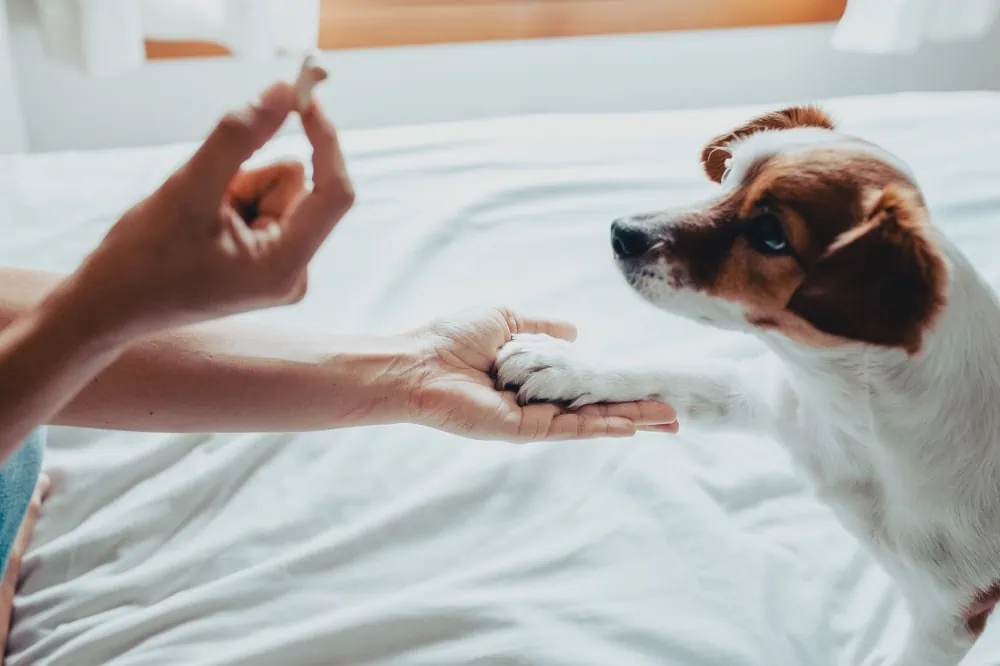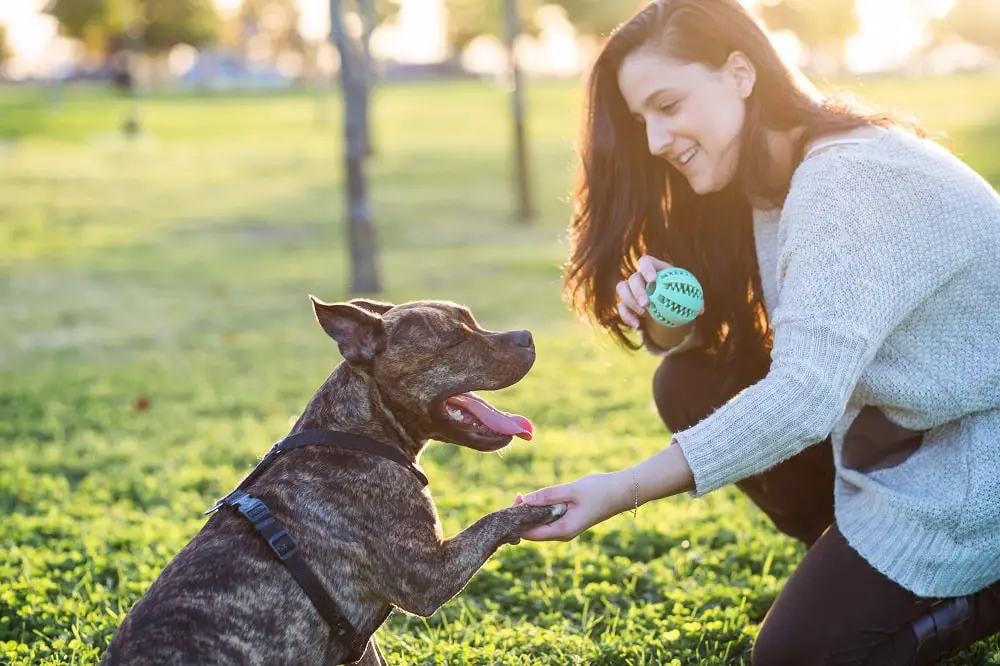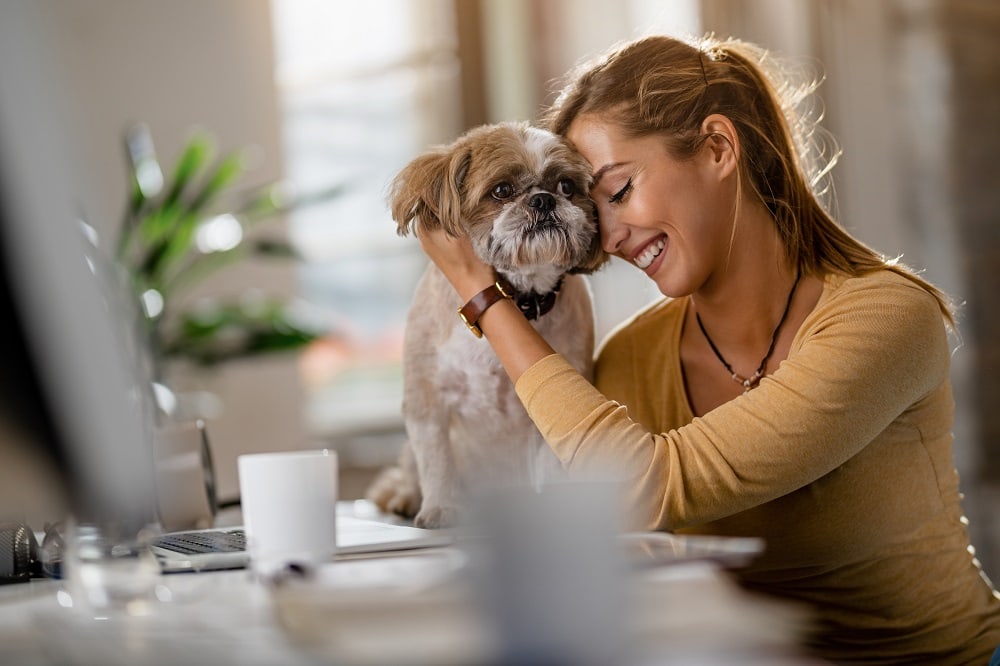Whether a puppy or an older dog, you can start training your dog to shake paws with a few simple tasks. You’ll need patience, consistency, positive rewards, and of course, breaks for both you and your pet.
How do you train your dog to shake paws? You can teach your dog to shake paws by hiding her favorite treat in your fist, extending that fist and waiting until she paws it, and giving her the treat immediately after. Then, with a few additional exercises, you’ll show her how to paw your open hand with a verbal cue, and finally, to shake a paw on command.
Hopefully, this will bust the myth that “old dogs can’t learn new tricks,” and your pet will be shaking hands in no time.
Setting Your Dog Up For Success
Dog training is an ancient skill that has been documented and improved for centuries. So, there’s no need to reinvent the wheel or worry.
Even better, teaching your dog to shake paws is one of the oldest tricks.
However, before moving on to the proper steps to train your pet, it’s important to know how to be prepared and have everything ready.
This way, you can focus only on spending time with your dog, having fun, and watching her become a professional “paw-shaker.”
First, you will probably want to teach your dog to sit. We’ve got some tips for you to do that in this article.
Keeping Your Dog’s Attention
Before you get started, make sure you remove possible distractions for your pet. What can be a distractor? Anything from flashy toys or other pets to the sounds of cars passing.
It’s more than just keeping your dog’s attention. Constant distractions could promote the wrong behavior-reward association. Later, you’re encouraged to add distractions. However, in the beginning, you should reduce them as much as possible.
Also, consider practicing for only ten to fifteen minutes every day. Try not to go for more than half an hour, and if you do, take small breaks in between to keep the mood positive for both you and your pet.
Finally, make sure you have her favorite treat at hand (literally). Treats will be the base of your reward system. We’ll provide examples with a food-based reward system, but you could use toys, or even just affection, too.
Increase Chances Of Success
For best results, take your dog’s personality into consideration and work with it. For example, if your pet is energetic, you might struggle to keep her attention for extended periods of time.
In that case, you could plan for shorter training intervals, and then increase as she becomes more skilled in the trick you are teaching.
Your dog’s personality will determine the best reward for her. Most dogs react well to snacks: bacon, jerky, apples, commercial dog treats, etc.
However, others love being rewarded with a favorite toy. Learn what works best for your pet and go with it.
Finally, complement the reward with sweet-talk and affection as she receives the treat or toy. The human-dog positive bond will be your best ally in training your pet (source).
Keep Calm And Practice
You’ll see the best results by being patient and keeping good energy around your dog. Getting angry, raising your voice, or even manipulating her paws to touch your hands can cause anxiety.
If that happens, your dog will take longer to learn, and she’ll get stressed when she has to shake.
Look at training your dog as a moment to improve and strengthen the bond between you two. When you train your dog with a positive reward system, your dog also learns to trust you more.
And, it gives you more freedom to do more with your pet.
For example, a trained dog can be walked without a leash, trusted to be left home alone, or interact with other people or children. When you’re completely at ease with your pet, your dog will be at ease and trust you, too.
Basic Steps To Teach Your Dog To Shake A Paw

Humans have documented several ways to train dogs to perform different tasks. You’ll find a system for pretty much anything you want to teach your dog.
Below is a summary of the most common steps and recommendations to train your dog to shake paws. Practice diligently, and enjoy the process!
Let Your Dog Figure It Out
When training your dog to “shake hands,” in the beginning, it’s vital to wait and let your pet attempt to figure things out by herself.
Don’t voice commands or signal anything, as this could create a confusing behavior association. Just wait patiently, in silence, with your fist held out toward her (source).
Then, follow each of the steps below:
- Hold a treat in your fist and hide it.
- Extend that fist to your dog’s nose.
- When your pet paws the fist, give her the treat, and pet her.
- Repeat the previous steps until your dog’s first reaction is to paw your fist.
At first, your dog might lick, nibble, sniff or do other things to get you to open your hand. It’s important to remain patient, stay quiet, and let your dog figure it out.
You should reward your dog immediately after she paws your fist.
You’ll know you’re progressing when your dog takes less time to paw your hand, instead of using other methods to open it.
Once your pet’s first reaction is to paw your fist, you can move to the next step.
Delay The Reward To Introduce A New Behavior
In this stage, you won’t reward her after she paws at your hand. Instead, reward your pet after her paw rests for one second on your fist.
Again, don’t give any verbal commands or signs and wait patiently. Follow the steps below as you move toward increasing the duration of time between the skill you are looking for and the reward you give.
- Extend your fist and let her paw rest on your fist.
- Reward your dog after one full second of her paw resting on your fist.
Now, practice this until your dog’s default response is to rest her paw on your fist for a second, every time. Only when that’s her default response should you continue with the additional steps below.
Introduce Verbal Cues
Verbal cues, or commands, can be introduced at this stage. Remember, it’s important that your pet is confidently resting her paw on your fist. Once she does that without hesitation, you can continue.
A fun part about this is to choose the command you want to use. You can say anything you want, like “shake” or “high-five.”
You could even try a different language! Just keep it short and easy for you to pronounce and her to understand. To learn more about training using other languages, you can read the article titled Dutch Dog Commands.
Here’s what you’ll need to do to introduce a verbal cue:
- Say the command.
- Extend your hand.
- Let your dog’s paw rest for a second on your hand.
- Reward your dog.
Your dog must associate a cue, behavior, and reward. So, you will need to do things in that order.
You can move to the next level once your dog is able to consistently follow this new behavior pattern: hearing your verbal cue, seeing your hand, and resting her paw on it for one second.
This has to happen every time you have her attention and each time you say the cue loud and clear. After that, you can move on to the next step.
Shaking Paws
We’ll divide this stage into two parts: introducing an open hand and “shaking hands.” By this point, your dog should be able to react to the verbal cue and rest a paw for one second on your fist without much hesitation.
After that, you’ll change a closed fist for an open hand. Now, you won’t use your fist anymore. Instead, you’ll show your dog your palm and she should rest her paw there for one second.
Finally, you’ll introduce a very gentle shake of her paw. Do this only after your dog is comfortable hearing the verbal cue, seeing your open palm, resting her paw on it, and getting a reward.
When her reaction is the same every time, then you can close your hand around her paw, shake it gently, release it, and give her a reward.
Here are more details about the process.
Introducing an open hand
For this part, keep your usual reward hidden. For example, you can hold it behind your back with your one hand while you train your dog with the other hand.
Whatever you choose, it must be readily available to reward her immediately, without it being a visible distraction.
Also, your dog might be a little nervous at first. She was used to working with a fist, and now there’s an open hand. Again, be patient. You can reach down a little to help her understand but never force her.
- Say the verbal cue.
- Extend your open hand.
- Let her paw and your palm meet.
- Reward and praise her immediately.
She might second guess herself at the beginning since now your hand will be extended. You have to give her time and practice.
She’ll be ready for the next part when she can confidently hear the verbal cue, rest her paw on your palm, and expect her reward.
“Shaking hands”
Then, after she’s more confident about reaching out to your extended hand, you can introduce shaking her paw.
- Say the verbal cue.
- Extend your open hand.
- Let her paw and your hand meet.
- Shake her paw gently.
- Release it.
- Reward and praise her immediately after releasing her paw.
Remember that it takes patience and lots of precise repetition. Repeat steps one to five of this section until your pet follows them without hesitation.
Once your dog shakes paws confidently with you, from the verbal cue to the actual shake, you can ask a friend or family member to practice these last steps with your dog.
That way, she’ll learn to react to the verbal cue, regardless of the person saying it.
Finally, you can remove the dog treat for the behavior pattern. Little by little, after maybe one more month of practice with treats, you can remove them.
However, it’s important to always reward her. How? Petting her emphatically and telling her words of encouragement is a great way to do so.
Regardless, you’ll always need to use the verbal cue. If you remove the verbal cue, your dog will likely get confused or completely forget how to shake paws. Always use the command or cue you’ve chosen.
Taking It To The Next Level

If you want to teach your dog to shake with the other leg, you’ll have to start the process of training from step one all over.
Begin from hiding a treat in your fist, and work your way, slowly, to introducing a verbal cue and removing dog treats in favor of using a verbal cue only.
Experts recommend mirroring paws and hands for the best results. For example, teach her how to shake your right hand with her left leg (source).
So, once again, you’ll need to extend your fist with a reward and patiently wait until she paws your hand. Then, you can start increasing the level of complexity.
Adding distractions to reinforce the behavior.
Once you’ve succeeded at home, the next step is to train your pet outside.
Training your pet in an environment with a lot of stimulation or distraction can be challenging. That’s why it’s recommended that you take your time and wait until she has learned well at home.
Preferably, introduce distractions gradually (source). For example, you can start leaving her favorite toy around, and repeat the verbal cue until your pet shakes a paw.
Later, you could train your dog with kids around or outdoors, as long as there aren’t many animals around since that’s a tough distraction for your pet to ignore.
Just keep in mind that rewards have to be more enticing than distractions. So, as you increase the level of distractors, you’ll need to increase the stimulus – the reward you give your dog.
Again, pay attention to your pet. For some dogs, the most rewarding thing could be their favorite toy. However, other dogs might need a chunk of chicken breast. Learn what is important for your dog and use that for training outdoors, especially as you introduce distractors.
If the dog finds a distractor more rewarding than doing what you want, she’ll go for the distractor. By giving your pet more enticing rewards, you are showing her that she’ll always get something better if she first heeds your commands and cues (source).
Things To Keep In Mind

Dog training is a discipline that has been mostly “figured out.” Experts have documented the most effective processes and techniques to train the domestic dog’s brain.
In other words, although improvement is always welcomed, everything you need to know about dog training is already out there. So, as long as you follow instructions, you won’t struggle with the technical part of training your pet.
However, like other animals, canines also have distinct, individual personalities. It’s undeniable that certain dog breeds can show similar personality traits, for example, friendly Labradors or loud Chihuahuas.
But, in the end, every pet is different and owners have to work with, not against, that unique personality, if they want their pet to learn well.
In this section, you’ll find advice to address or prevent any possible setbacks that could arise from your dog’s personality, the environment, or even your own mood.
Do Not Manipulate Your Pet’s Body
For example, if your dog doesn’t paw your hand after 3-5 minutes, you can get your fist closer to her paw. However, if you grab her leg and pull it to your hand, she might recoil, get stressed, or believe that she has to wait for you to grab her.
Patiently waiting will always have the best results.
If Your Dog “Fails” At A Stage, Go Back To The Previous Step
There’s no way around it. If your dog is finding a step difficult, then you have to go back a step.
In essence, dogs learn by associating sequences of actions (connecting the dots). If your pet doesn’t “connect the dots” properly before moving on, she might be learning something different than what you’re trying to teach.
That’s why it’s important to introduce one action at a time and practice it until it becomes natural for your dog.
For example, if you try to introduce the verbal cue before your dog rests her paw on your palm confidently, then she might associate the cue with removing her paw fast, instead of leaving it there for one second.
Also, you can’t “reason” with a dog. So, if you move on to the next step, but your dog isn’t ready, you might get frustrated or angry.
Remember, negative emotions around training defeat the purpose because your dog will sense your anger, and it will result in stress for your dog.
Keep Training And Practicing
Dogs can learn new tricks, regardless of their age. However, they can also forget them really fast. Puppies and adolescent dogs are known to forget their training if their owners don’t practice consistently (source).
So, once your dog can shake a paw, practice with her a few days a week. It’s OK to reduce treats as a reward, but don’t remove rewards altogether.
Instead of a treat, at the very least, pet her emphatically as a reward. You could also give her her favorite toy. Regardless of your choice, there has to be a reward, always.
Constant practice ensures the dog never forgets. On top of that, it keeps your dog motivated to learn new tricks in the future.
“Listen” To Your Dog
Your dog loves you, and she’ll be happy to spend time with you. Dogs are great learners, but they are also like little kids. Pay attention to your pet’s level of interest and energy.
If your pet looks bored, maybe you could take a break and try again later. However, if your pet looks tired, just let her rest.
Learning to shake paws is fun, but letting your dog be happy is essential.
To learn some quick and easy steps, check this video here:
Always End On A Positive Note
The Central Intelligence Agency (CIA) – when training the most difficult tasks for their dogs’ roles and responsibilities recommend that training sessions always end with “an easy win” for the pup (source). The same goes for more simple home training and tricks.
Maybe, your dog couldn’t improve when moving to the next stage in your training. Then, “review” the previous step, with just one repetition, and give her a reward. It’s okay to move back a step before progressing forward.
This is particularly important if you are getting frustrated in the process. Your dog is aware of that and, contrary to popular belief, emotional manipulation doesn’t work on pets. Instead, they mirror that emotion.
With a small win, a treat, and words of encouragement, you and your dog can finish on a positive note. You’ll end your training feeling happy and ready to try again tomorrow.
Final Thoughts
Pets are brilliant creatures with an ancient, unique connection to us. Particularly, dogs and humans have a long history of symbiosis.
Nowadays, training is part of that ongoing connection as our lifestyles have evolved and dogs have turned into companions, instead of work tools. However, dogs are still eager to participate whenever you include them.
Training your pup is one of the best ways to bond with her and add more meaning to your connection.


0 Comments